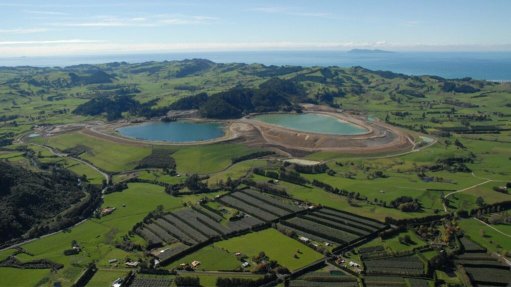
The Waihi mine on New Zealand's North Island.
JOHANNESBURG (miningweekly.com) – Australia-based OceanaGold on Thursday published its 2018 production guidance, stating that its four mines in the Philippines, New Zealand and the US would produce between 480 000 oz and 530 000 oz of gold and 15 000 t to 16 000 t of copper.
The Didipio and Waihi mines, in the Philippines and New Zealand respectively, will produce less ounces this year than last year, but production will be higher at the Haile mine, in the US, and the Macraes mine, in New Zealand.
Didipio’s production could fall by as much as 55% to between 80 000 oz and 90 000 z, from 176 790 oz produced in 2017, as a higher proportion of lower-grade stockpile will be treated, while the higher-grade production from the newly developed underground mine is being ramped up. An increased proportion of higher grade mill feed is expected to come from the underground mine from 2019 onwards, which should return the mine’s output to between 110 000 oz and 130 000 oz.
“We see 2018 as a year of transition for the asset through the steady ramp-up of mining rates from panel one in the underground and continued development of panel two,” said president and CEO Mick Wilkes.
Didipio should also produce between 15 000 t and 16 000 t of copper this year.
The lower output from Didipio will be offset by an increase in output from the Haile mine, in South Carolina, and the Macraes mine, on New Zealand’s South Island.
The Haile mine is forecast to produce between 135 000 oz and 155 000 oz in 2018, which is a 20% to 25% increase from 2017’s output.
OceanaGold also announced a growth capital investment of between $40-million and $45-million for Haile for 2018. Capital expenditures (capex) at Haile would include the procurement and installation of a pebble crusher, tower mill and Isa mill for additional grinding capacity, as well as other infrastructure required to debottleneck the plant and incrementally increase plant throughput rates towards the optimised design of between 3.5-million tonnes a year and 4-million tonnes a year.
Plant recoveries at Haile had consistently averaged in the low 80% range since the start of commercial production, with the grind size being 19 microns. The miner explained that the installation of additional fine grinding capacity should reduce the grind size to 13 microns, which would further increase recoveries.
In New Zealand, a solid year is forecast for the Macraes mine, with production also expected to be 20% higher at between 190 000 oz to 200 000 oz. The higher production is mainly attributed to higher grades from Coronation North. OceanaGold said that higher production and improved margins were expected to persist through 2019 and into 2020.
The Waihi mine, on North Island, is forecast to produce between 75 000 oz and 85 000 oz.
Group all-in sustaining costs are forecast at $725/oz to $775/oz.
Total capex spend for 2018 is forecast to be between $210-million and $255-million, of which $102-million to $116-million will be growth expenditure.